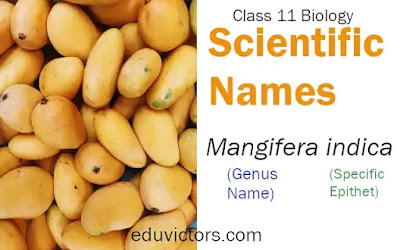Blog provides NCERT solutions, CBSE, NTSE, Olympiad study material, model test papers, important Questions and Answers asked in CBSE examinations. References to Educational Sites and resources.
Sunday 4 October 2020
English Reading Comprehension (Set-16) - for Class 9 and 10 (#readingcomprehension)(#eduvictors)(#class10English)
Saturday 3 October 2020
Biology - Scientific Names (#Class11Biology)(#NEET)(#Class12Biology)(#Class9Biology)
Biology - Scientific Names
1. Swedish botanist Carolus Linnaeus established binomial nomenclature.
2. Caper Bauhin expressed proposed binomial nomenclature for the first time
3. In binomial nomenclature, the first word is a generic name having first letter capital and second word is a specific epithet having first letter. e.g. Homo sapiens, Mangifera indica
4. After end of biological name, the name of author is written in abbreviated form who gave the name to that organism.
5. Both the words of a biological name when handwritten are separately underlined and when printed are typed in italics to indicate their Latin origin and also give respect to the name.

Friday 2 October 2020
CBSE Class 12 - Physical Education - Chapter - Psychology and Sports- Personality Types (Questions and Answers)(#PhysicalEducation)(#cbseClass12)(#eduvictors)
Chapter - Psychology and Sports- Personality Types (Questions and Answers)
CBSE Class 12 - Physical Education

Thursday 1 October 2020
CBSE Class 10 Chemistry - Chapter 1: Chemical Reactions and Equations (Part-3)(#class10Chemistry)(#eduvictors)(#chemicalreactions)
CBSE Class 10 Chemistry - Chapter 1: Chemical Reactions and Equations (Part-3)(Q & A)
The first chapter of Chemistry talks about chemical reactions and equations. In a chemical reaction, reactants are transformed into products. In this series, the part-3 video discusses types of chemical reactions.
Following questions are covered:
Q1: What are the important types of chemical reactions.
Q2: What are combination reactions? Give examples.
Q3: Hydrogen burns in oxygen to form water. Identify the type of reaction.

Monday 28 September 2020
CBSE Class 7 - Science - Fibre to Fabric - Worksheet (#cbsenotes)(#eduvictors)(#NCERTClass7Science)
Class 7 - Science - Fibre to Fabric - Worksheet
Fill in the blanks with suitable words
1. _________ and _________ fibres are obtained from animals.
2. The famous Pashmina shawls come from the soft under-fur of the ________ goat.
3. Silk fibres come from _________ of silk _________.
4. Liama and Alpaca also yield_____________ and are found in_____________.

Saturday 26 September 2020
CBSE Class 10 Maths Revision Assignment -2 (#eduvictors)(#cbse)(#class10Maths)
Class 10 Maths Revision Assignment -2
1-Mark Questions
Chapters: Introduction to Trigonometry, Applications of Trigonometry, Statistics, Probability

Friday 25 September 2020
CBSE Class 8 - Science - Combustion and Flame (Worksheet)(#class8Science)(#combustion)(#eduvictors)
Class 8 - Science - Combustion and Flame (Worksheet)

Thursday 24 September 2020
Class 10 Maths - Revision Assignment - 1 (1 - Mark Questions - Answers) (#class10Maths)(#cbse2020)(#eduvictors)
Class 10 Maths - Revision Assignment - 1
Chapters covered: Real Numbers, Polynomials, Arithmetic progressions, Co-ordinate Geometry, Introduction to Trigonometry
1-Mark based Questions (with Answers)
Q1: What is the HCF of the smallest composite number and the smallest prime number?
Answer: Smallest composite number = 4
Smallest prime number = 2
HCF (4, 2) = 2
Q2: If HCF of a and b is 12 and product of these numbers is 1800. What is the LCM of these numbers?
Answer: a × b = HCF × LCM
⇒ 1800 = 12 × LCM
⇒ LCM = 1800 / 12 = 150

Tuesday 22 September 2020
CBSE Class 10 - History - NATIONALISM IN INDIA (MCQs-2)(#nationalismInIndia)(#class10History)(#eduvictors)
NATIONALISM IN INDIA (MCQs-2)
CBSE Class 10 - History
Directions: Read the questions carefully and pick up the correct choice.
Q1: Which of the following is true with reference of Satyagraha?
(Ⅰ) It emphasized muscle power
(Ⅱ) It emphasized the power of truth
(Ⅲ) Gandhiji successfully fought the racist regime of South Africa with the novel method.
(a) Only Ⅰ is true
(b) Only Ⅱ is true
(c) Both Ⅰ and Ⅱ are true
(d) Both Ⅱ and Ⅲ are true
Q2: At which place congress session of September 1920 held.
(a) Nagpur
(b) Calcutta
(c) Lahore
(d) Madras

Monday 21 September 2020
Effect of exercise on Cardio Respiratory System - CBSE Class 12 Physical Education - Chapter 7: Physiology & Injuries in Sports (Questions and Answers)(#eduvictors)(#PhysicalEducation)
Effect of exercise on Cardio-Respiratory System - (Questions and Answers)
Class 12 Physical Education - Chapter 7: Physiology & Injuries in Sports
Q1: What are the physiological effects of physical activity/exercise on our organ systems?
Answer: Physical activity has numerous beneficial physiological effects on the cardiovascular and musculoskeletal systems, but it also benefits the metabolic, endocrine, and immune systems.

